Use of major histocompatibility complex class I/peptide/beta2M tetramers to quantitate CD8(+) cytotoxic T lymphocytes specific for dominant and nondominant viral epitopes in simian-human immunodeficiency virus-infected rhesus monkeys
- PMID: 10364294
- PMCID: PMC112603
- DOI: 10.1128/JVI.73.7.5466-5472.1999
Use of major histocompatibility complex class I/peptide/beta2M tetramers to quantitate CD8(+) cytotoxic T lymphocytes specific for dominant and nondominant viral epitopes in simian-human immunodeficiency virus-infected rhesus monkeys
Abstract
To evaluate the impact of the diversity of antigen recognition by T lymphocytes on disease pathogenesis, we must be able to identify and analyze simultaneously cytotoxic T-lymphocyte (CTL) responses specific for multiple viral epitopes. Many of the studies of the role of CD8(+) CTLs in AIDS pathogenesis have been done with simian immunodeficiency virus (SIV)- and simian-human immunodeficiency virus (SHIV)-infected rhesus monkeys. These studies have frequently made use of the well-defined SIV Gag CTL epitope p11C,C-M presented to CTL by the HLA-A homologue molecule Mamu-A*01. In the present study we identified and fine mapped two novel Mamu-A*01-restricted CTL epitopes: the SIVmac Pol-derived epitope p68A (STPPLVRLV) and the human immunodeficiency virus type 1 (HIV-1) Env-derived p41A epitope (YAPPISGQI). The frequency of CD8(+) CTLs specific for the p11C,C-M, p68A, and p41A epitopes was quantitated in the same animals with a panel of tetrameric Mamu-A*01/peptide/beta2m complexes. All SHIV-infected Mamu-A*01(+) rhesus monkeys tested had a high frequency of SIVmac Gag-specific CTLs to the p11C,C-M epitope. In contrast, only a fraction of the monkeys tested had detectable CTLs specific for the SIVmac Pol p68A and HIV-1 Env p41A epitopes, and these responses were detected at very low frequencies. Thus, the p11C,C-M-specific CD8(+) CTL response is dominant and the p41A- and p68A-specific CD8(+) CTL responses are nondominant. These results indicate that CD8(+) CTL responses to dominant CTL epitopes can be readily quantitated with the tetramer technology; however, CD8(+) CTL responses to nondominant epitopes, due to the low frequency of these epitope-specific cells, may be difficult to detect and quantitate by this approach.
Figures
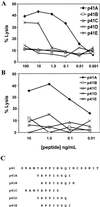
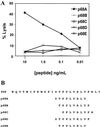
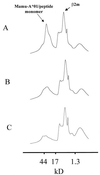
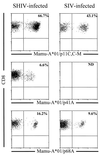
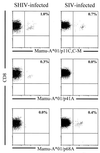
Similar articles
-
Analysis of Gag-specific cytotoxic T lymphocytes in simian immunodeficiency virus-infected rhesus monkeys by cell staining with a tetrameric major histocompatibility complex class I-peptide complex.J Exp Med. 1998 May 4;187(9):1373-81. doi: 10.1084/jem.187.9.1373. J Exp Med. 1998. PMID: 9565630 Free PMC article.
-
Definition of human immunodeficiency virus type 1 gp120 and gp41 cytotoxic T-lymphocyte epitopes and their restricting major histocompatibility complex class I alleles in simian-human immunodeficiency virus-infected rhesus monkeys.J Virol. 1996 Oct;70(10):7335-40. doi: 10.1128/JVI.70.10.7335-7340.1996. J Virol. 1996. PMID: 8794394 Free PMC article.
-
A simian immunodeficiency virus nef peptide is a dominant cytotoxic T lymphocyte epitope in Indian-origin rhesus monkeys expressing the common MHC class I allele mamu-A*02.Virology. 2002 Sep 30;301(2):365-73. doi: 10.1006/viro.2002.1598. Virology. 2002. PMID: 12359438
-
Simian immunodeficiency virus-specific cytotoxic T lymphocytes in rhesus monkeys: characterization and vaccine induction.Semin Immunol. 1993 Jun;5(3):215-23. doi: 10.1006/smim.1993.1025. Semin Immunol. 1993. PMID: 8394161 Review.
-
Cytotoxic T lymphocytes specific for the simian immunodeficiency virus.Immunol Rev. 1999 Aug;170:127-34. doi: 10.1111/j.1600-065x.1999.tb01334.x. Immunol Rev. 1999. PMID: 10566147 Review.
Cited by
-
Viral escape from dominant simian immunodeficiency virus epitope-specific cytotoxic T lymphocytes in DNA-vaccinated rhesus monkeys.J Virol. 2003 Jul;77(13):7367-75. doi: 10.1128/jvi.77.13.7367-7375.2003. J Virol. 2003. PMID: 12805435 Free PMC article.
-
Novel adeno-associated virus vector vaccine restricts replication of simian immunodeficiency virus in macaques.J Virol. 2005 Jan;79(2):955-65. doi: 10.1128/JVI.79.2.955-965.2005. J Virol. 2005. PMID: 15613324 Free PMC article.
-
Diverse cross-reactive potential and Vbeta gene usage of an epitope-specific cytotoxic T-lymphocyte population in monkeys immunized with diverse human immunodeficiency virus type 1 Env immunogens.J Virol. 2009 Oct;83(19):9803-12. doi: 10.1128/JVI.00776-09. Epub 2009 Jul 29. J Virol. 2009. PMID: 19640988 Free PMC article.
-
Replication-defective adenovirus serotype 5 vectors elicit durable cellular and humoral immune responses in nonhuman primates.J Virol. 2005 May;79(10):6516-22. doi: 10.1128/JVI.79.10.6516-6522.2005. J Virol. 2005. PMID: 15858035 Free PMC article.
-
Early detection of dominant Env-specific and subdominant Gag-specific CD8+ lymphocytes in equine infectious anemia virus-infected horses using major histocompatibility complex class I/peptide tetrameric complexes.Virology. 2005 Aug 15;339(1):110-26. doi: 10.1016/j.virol.2005.05.025. Virology. 2005. PMID: 15979679 Free PMC article.
References
-
- Allen T M, Sidney J, del Guercio M F, Glickman R L, Lensmeyer G L, Wiebe D A, DeMars R, Pauza C D, Johnson R P, Sette A, Watkins D I. Characterization of the peptide binding motif of a rhesus MHC class I molecule (Mamu-A*01) that binds an immunodominant CTL epitope from simian immunodeficiency virus. J Immunol. 1998;160:6062–6071. - PubMed
-
- Altman J D, Moss P A H, Goulder P J R, Barouch D H, McHeyzer-Williams M G, Bell J I, McMichael A J, Davis M M. Phenotypic analysis of antigen-specific T lymphocytes. Science. 1996;274:94–96. - PubMed
-
- Busch D H, Pilip I M, Vijh S, Pamer E G. Coordinate regulation of complex T cell populations responding to bacterial infection. Immunity. 1998;8:353–362. - PubMed
-
- Chen Z W, Kou Z C, Lekutis C, Shen L, Zhou D, Halloran M, Li J, Sodroski J, Lee-Parritz D, Letvin N L. T cell receptor V beta repertoire in an acute infection of rhesus monkeys with simian immunodeficiency viruses and a chimeric simian-human immunodeficiency virus. J Exp Med. 1995;182:21–31. - PMC - PubMed
Publication types
MeSH terms
Substances
Grants and funding
LinkOut - more resources
Full Text Sources
Other Literature Sources
Research Materials

